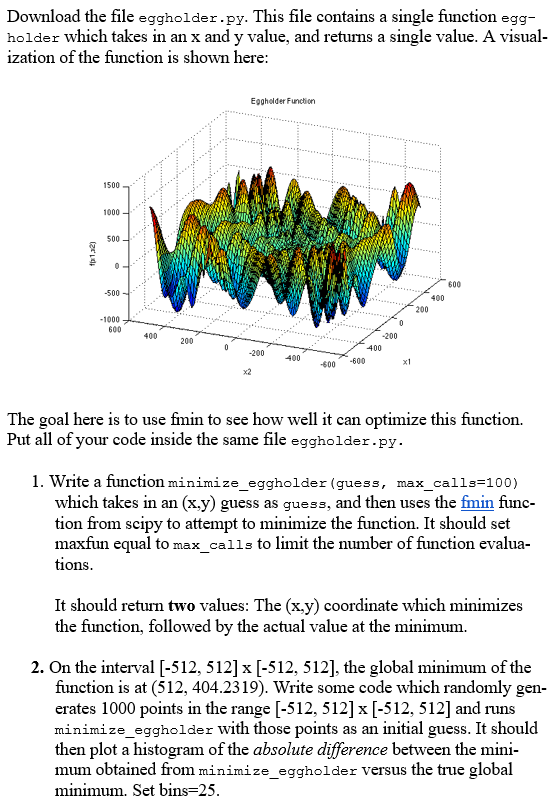Question
Use eggholder.py. (code below) for this question v import numpy as np def eggholder(x, y): Takes in either a scalar x and y, or
Use eggholder.py. (code below) for this question
v
import numpy as np
def eggholder(x, y):
"""
Takes in either a scalar x and y, or a 1-D numpy array for both x and y.
"""
if (isinstance(x, np.ndarray) and not isinstance(y, np.ndarray)) or (
isinstance(y, np.ndarray) and not isinstance(x, np.ndarray)):
pass
result = -(y + 47) * np.sin(np.sqrt(np.abs(x / 2 + (y + 47)))) - x * np.sin(np.sqrt(np.abs(x - (y + 47))))
if isinstance(x, np.ndarray):
outside = (np.abs(x) > 512) | (np.abs(y) > 512)
result[outside] = 2000
return result
else:
return 2000 if (abs(x) > 512 or abs(y) > 512) else result
^
code screen shot 

Use python 3.8 thank you
import numpy as np def eggholder(x, y): Takes in either a scalar x and y, or a 1-D numpy array for both x and y. if (1sinstance(x, np.ndarray) and not 1sinstance(y, np.ndarray)) or ( 1sinstance(y, np.ndarray) and not isinstance(x, np.ndarray)): pass result = -(y + 47) np.sin(np. sqrt(np.abs(x / 2 + (y + 47)))) - X * np.sin(np. sqrt(np.abs(x - (y + 47)))) 1f 1sinstance(x, np.ndarray): outside = (np.abs(x) > 512) | (np.abs(y) > 512) result(outside) = 2000 return result else: return 2000 if (abs(x) > 512 or abs(y) > 512) else result Download the file eggholder.py. This file contains a single function egg- holder which takes in an x and y value, and returns a single value. A visual- ization of the function is shown here: Egghelder Function 1500 1000 500 1,22) -500 600 400 200 -1000 600 400 200 0 -200 -200 400 -600 400 x1 -600 x2 The goal here is to use fmin to see how well it can optimize this function. Put all of your code inside the same file eggholder.py. 1. Write a function minimize_eggholder (guess, max_calls=100) which takes in an (x,y) guess as guess, and then uses the fmin func- tion from scipy to attempt to minimize the function. It should set maxfun equal to max_calls to limit the number of function evalua- tions. It should return two values: The (x,y) coordinate which minimizes the function, followed by the actual value at the minimum. 2. On the interval [-512, 512] x [-512, 512], the global minimum of the function is at (512, 404.2319). Write some code which randomly gen- erates 1000 points in the range [-512, 512] x [-512, 512] and runs minimize_eggholder with those points as an initial guess. It should then plot a histogram of the absolute difference between the mini- mum obtained from minimize_eggholder versus the true global minimum. Set bins=25. import numpy as np def eggholder(x, y): Takes in either a scalar x and y, or a 1-D numpy array for both x and y. if (1sinstance(x, np.ndarray) and not 1sinstance(y, np.ndarray)) or ( 1sinstance(y, np.ndarray) and not isinstance(x, np.ndarray)): pass result = -(y + 47) np.sin(np. sqrt(np.abs(x / 2 + (y + 47)))) - X * np.sin(np. sqrt(np.abs(x - (y + 47)))) 1f 1sinstance(x, np.ndarray): outside = (np.abs(x) > 512) | (np.abs(y) > 512) result(outside) = 2000 return result else: return 2000 if (abs(x) > 512 or abs(y) > 512) else result Download the file eggholder.py. This file contains a single function egg- holder which takes in an x and y value, and returns a single value. A visual- ization of the function is shown here: Egghelder Function 1500 1000 500 1,22) -500 600 400 200 -1000 600 400 200 0 -200 -200 400 -600 400 x1 -600 x2 The goal here is to use fmin to see how well it can optimize this function. Put all of your code inside the same file eggholder.py. 1. Write a function minimize_eggholder (guess, max_calls=100) which takes in an (x,y) guess as guess, and then uses the fmin func- tion from scipy to attempt to minimize the function. It should set maxfun equal to max_calls to limit the number of function evalua- tions. It should return two values: The (x,y) coordinate which minimizes the function, followed by the actual value at the minimum. 2. On the interval [-512, 512] x [-512, 512], the global minimum of the function is at (512, 404.2319). Write some code which randomly gen- erates 1000 points in the range [-512, 512] x [-512, 512] and runs minimize_eggholder with those points as an initial guess. It should then plot a histogram of the absolute difference between the mini- mum obtained from minimize_eggholder versus the true global minimum. Set bins=25Step by Step Solution
There are 3 Steps involved in it
Step: 1

Get Instant Access to Expert-Tailored Solutions
See step-by-step solutions with expert insights and AI powered tools for academic success
Step: 2

Step: 3

Ace Your Homework with AI
Get the answers you need in no time with our AI-driven, step-by-step assistance
Get Started


